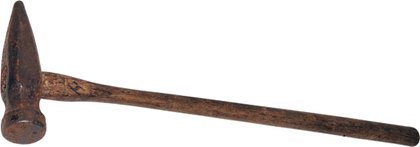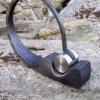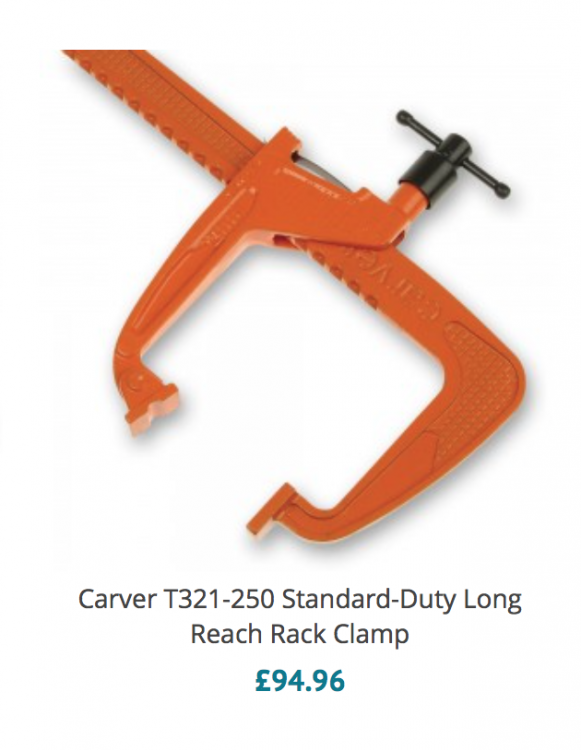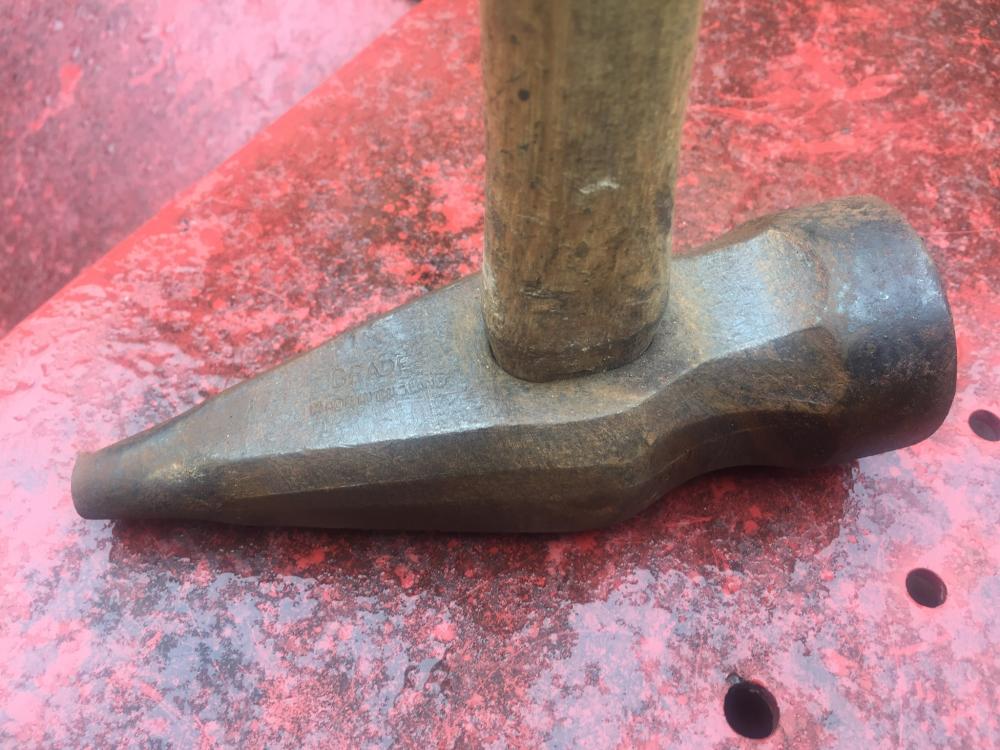-
Posts
1,990 -
Joined
-
Last visited
Content Type
Profiles
Forums
Articles
Gallery
Downloads
Events
Posts posted by Alan Evans
-
-
It is a good investment, you will not regret. But I choose my words carefully...investment equals serious money!
I have 6 of the slightly longer reach ones than Iron Dwarf posted and couple of the big boys with a straight bar to use for spreading.
Alan
The Carver Standard-Duty Long Reach Rack Clamps have many uses. The most common include welding, metal fabrication, moulding box and die holding, plate fabrication, plastic and fibreglass moulding and maintenance work.
The Carver T321-250 Standard-Duty Long Reach Rack Clamp has the following specifications:
Capacity: 250mm (10in).
Reach: 120mm (4.3/4in).
Overall Length: 360mm (14.1/8in).
Clamping Force: 5,650N.
Weight: 2.0kg.
The standard reach ones like Iron Dwarf's have double the clamping force:-
The Carver T186-300 Standard-Duty Rack Clamp has the following specifications:
Capacity: 150mm or 294mm
Reach: 60mm
Overall Length: 245mm or 395mm
Clamping Force: 11,300N
-
33 minutes ago, bubba682 said:
Are you talkin about the the tables with all the square holes and those clamps i'll have to look em up to see if there the ones im thinkin of.Just went and searched them i ve never used that style we do use them along that style but i havn't worked in a fab shop in years so they might have the exact ones but i'm not sure.I might have to order a set give them a try.
Not the table no...they are the orange two piece clamps with the shrouded screw and the notched coarse adjustment.
Alan
-
6 minutes ago, ausfire said:
Alan,
Thank you. Some wise advice on back care there. I have taken note ... should have done so years ago. Things tend to catch up on you. Thanks for your concern.
Don't they just.
I celebrated my 40th birthday at the ABANA conference in Saint Luis Obispo. Lesley came over with me and she attended an early morning session on backs. The tutor/speaker mentioned that our backs are good to survive mistreatment for 40 years or so then they complain.
A month after we got back my back went!
But 25 years of (occasional and ill-disciplined) exercise have kept me upright and working ever since.
Alan
-
I tend to use Vise-grips for light stuff, G cramps (C clamps to you!) just for wood work but I invested in a few Carver clamps for serious metal work. Most fabricators use them over here, are they available on your side of the Atlantic?
I suggested the straightening beads in case the OP did not have Oxy-Acetylene to hand...but its true...more fun playing with fire!
Alan
-
On 11/03/2017 at 0:51 AM, littleblacksmith said:
I enjoy grazing upon yellow woodsorrow. Has a nice lemony pickle taste.
Littleblacksmith
I am bitterly sorrel to hear that...
Alan
-
jeremy k and bubba682 refer to heat straightening...I know the process as "heat triangles" so that may give another line of research / help with googling. Very effective process, I have bent and straightened Channels, RSJs and Universal Columns in both planes with it.
The slight disadvantage in this instance is that it puts even more tension onto the weld area. But it is a quite normal procedure.
A couple of similar sized weld beads on the back of the TEE bar (immediately opposite / in alignment with / and parallel to the tee fillets) can do the same job and be almost invisible if you grind a Vee first.
If this is just for a base frame and is going to have castors why worry about the distortion anyway? It will be strongest left as laid and should not worry the castors.
If it was sitting on direct on the ground a plate welded on as a toe at either end would prevent it rocking on the centre...
Alan
-
8 hours ago, ausfire said:
Nothing for me today. A fine Sunday, lots of visitors to the forge and I'm sitting here in great discomfort playing on the computer. Another back spasm - pain injections and limited movement. GRRRRRR.
Sorry to hear about your back...is it disc, facet joint or muscle?
When I was on my back with a popped disc which damaged the sciatic nerve I found four things that helped...
Diclofenac-retard slow release anti inflammatory...ibu-profen wouldn't touch it.A marvellous Physiotherapist who manipulated my back a bit, but crucially showed me how it all worked mechanically and gave me the exercises I could do to get it better, regain and maintain my Lordosis and prevent it happening again.
A back swing which is a table which holds you by the ankles and you cause it to swing backwards and can hang upside down Dracula style...I used to watch an evenings tv...you get used to the upside down picture rapidly!
A book entitled "Treat Your Own Back" by a New Zealander Robin McKenzie ISBN: 978-0-9876504-0-5
Underlying each of the good things was exercise and movement...sitting around or lying in bed was not the best.
I have been able to carry on working for the last 25 years since the disc damage even working heavier metal than before...I still have a slightly numb big toe and developed a strange gait but I have been almost entirely pain free.
I have also heard from my Physiotherapist that Sarah Keys has some very good back advice...she is based in Oz and has a lot of youtube videos and informative websites.
Basic rules I gleaned for backs...
Sit tall, stand tall, don't slump.
Working at the computer or over the bench or anvil, take a few seconds to straighten up and push you hips forward and arch your back the other way every now and then.
A few wimps push ups leaving your tummy on the ground is an even better way to arch your back.
Exercise to keep the spine flexible and supple...it spreads the load and the bend.
Never exercise into pain or discomfort.
Feet at shoulder width, heels on the ground, and bend your knees not your back when lifting. Prepare somewhere to put it down before you pick it up.
Good luck. Hope some of that helps, Alan
-
A concave blade with a ball point like a tripe knife cutting outwards?
The "unzip" gralloching knife used by deer stalkers or the larger butchers' tripe knife cut from the inside out and avoid having to cut through the contents.
Alan
ps You can use the inside/outward cutting technique with any blade shape, but a concave one makes it easier to make a continuous cut and keep your hand clear of the packaging and contents...hay being so abrasive can skin your knuckles...I have used the technique with some success on Haylage bales...they only have had the multi layer plastic wrap rather than your net, and on other shrink-wrapped pallet loads. Alan
-
I remember seeing an old film of rivet throwing...I seem to remember the rivet heated on the dockside going up the side of the ship on stages of scaffolding in three or four throws and bucket catches to the riveters...most impressive.
Alan
-
The full length handled image is from the Belfast Museum and is listed as a riveters' hammer. The caption was not included for some reason. Third try.....
Alan
This rivet hammer was used to knock red hot rivets into steel plates. Riveting was an important part of building the Titanic. Riveting squads in the Harland & Wolff shipyard were usually three men and one or two young boys aged 14 or older. A boy heated the rivets in a furnace to a temperature of around 650 degrees Celsius. Then a boy, called a ‘Heater’ or ‘Rivet Catcher’, would hold it in tongs and run or climb to where it was needed before it cooled off.
-
Yes, mine is a steel drop forging, you can see the flashing shear on the sides.
Alan
-
The wax is just the carrier for the lubricant. The graphite does the lubricating job but you need something to hold it onto a wet and possibly warm punch.
The proportion of graphite to carrier is largely irrelevant. You want as much graphite as possible...the carrier just melts, burns or evaporates away.
I used Renaissance wax as the carrier for many years, and it works fine...nice smell as it burns away. Last few years I have been using Molyslip brand MWF (metalworking fluid) as the carrier.
MWF is a high temperature high pressure lubricant in its own right, but I haven't noticed that it is any more effective than the wax. It doesn't smell as good! It's big advantage though is that in the pot beside the press it does not dry out like the white spirit from the Renaissance wax, you have to keep thinning the wax/graphite pot down every month or so. The MWF/graphite pot just stays gloopy almost indefinitely.
I have tried just using water with the graphite but it was not anything like as good for my punch and drift tools in the press.
Basically anything that will hold some graphite onto the punch/drift surface will do, but be aware you are going to be breathing the fumes of whatever the carrier as it fries.
Alan Knight, the smith I trained with, always used to sprinkle some coal dust in the hole which he reckoned helped the punch release. I found that the easy release was much more to do with the profile of punch and technique. The coal dust was not effective for me.
I have done some empirical experimenting with lubricants and can confirm that graphite lubrication requires about half the tonnage to punch and drift when compared with no lubricant. Nothing clever, I just watch the pressure gauge on the press.
The difference can mean a successful hole or getting the punch stuck...or running out of oomph on a larger hole....
Alan
Ps just reread your OP. I use flake graphite. Bought in bulk from a graphite dealer. Rocol sell flake graphite in (expensive) kilo size tubs as industrial lubricant they call it Foliac. I use the same flake graphite mixed with paint for the burnished paint finish, so it is fine enough to go through the spray gun nozzle, but it is not the fine powder that locksmiths use.
-
I don't think it is a coal hammer. Mine is too heavy a beast for that.
The domestic coal hammers I have seen are much lighter and double ended...just a tapering to a hemisphere end.
If it was for an industrial or commercial sized furnace I would doubt the need to break the lumps down.
My one has a flat on the end of the taper so has all the appearance of a metal punch.
Maybe the big flat face was for driving a chisel or punch....I also keep thinking of slaters' drilling hammers and wondering about lead workers punching holes through sheet lead.
The taper could be used as a podger to align holes for riveting and the big flat face would be good for thumping a rivet head or rivet snap.
Two minutes later.....having thought of rivets I did a Google search on riveting hammer and hey presto!....
"Titanic riveting hammer" comes up.

Alan
-
On 7 March 2017 at 1:35 PM, Jasent said:
Another score from Gramps. Any idea what it was used for?
Don't know if it was designed for a specific purpose, but most likely it was.
I have one just like it, made by Brades.
I have used it as a hammer and as punch/drift with a sledge...nobody said I couldn't!

Alan
-
57 minutes ago, 58er said:
main question. Sand for floor?
or concrete
I find a stamped earth floor more comfortable to stand on all day.
But...the advantages of having a levelled concrete slab for laying out projects, generally keeping tidy and easy to put stuff on wheels or a pallet truck to shift it around, trump packed earth any day.
You can always leave a patch between the hearth and anvil un-concreted but you would be better off with well designed boots!
Alan
-
5 hours ago, Frosty said:
Grinding, filing, why? None of those are dies to produce finished pieces. Save the filing and sanding for the work, not the tools. Oh sure, knock off any burrs or stick up buggers but there isn't much good reason to shine them up. Seriously even if they were mirror polished by time you hammer out a ladel or bowel it's going to need some blemish removing.
Frosty The Lucky.
Couldn't agree less.
If you want to make spoons and dishes with coarse surface textures...and spend time on each one cleaning it up, fine. If you want to make spoons which are smooth and with a mirror polish it is much more efficient to clean up the tools and not put any marks onto the workpiece surface which have then got to be removed.
Best way to take marks out, is not to put them in.
Alan
-
10 hours ago, JHCC said:
It's for the sizing of common nails:
"In current usage in the United States, a 2d nail is 1 inch long. Each 1d increase is ¼ inch increase in length up to 10d followed by a 12d which is 3¼″ long. A sixteen-penny nail is a ¼ inch longer than 12d, and the remaining sizes, beginning with 20d, are multiples of 10 and are each ½ inch longer than the preceding size."
(source)
Thank you for the link, I have managed to delay lighting the furnace for another hour and a half following through the ongoing links!
I didn't spot the delightfully poetic Northumbrian/Cumbrian shepherd's counting system in it...which I still vaguely remember from a song by Jake Thackeray learned in my teens fifty years ago...Yan Tan Tether Mether Pip, Aysa Saysa Acka Conta Dick, Yan-a-dick Tan-a-dick Tether-a- Mether-a- Bumfit, Yan-a Bum Tan-a-Bum Tether-a-Bum Mether-a-Bum Jiggit...on Jiggit a pebble was passed from right to left hand...
I did realise it was the nail sizing system, my query was partially to flag up that it did not give some of the forum members a general idea of the size being described...and not just "look this up on google for me"!
Alan
-
2 hours ago, ThomasPowers said:
snip... had some nice 20 penny nails snip...
What are 20 penny nails? I have seen reference to ~ penny nails before. We normally go by the length and style (flat head, oval, panel pin, clout, roofing nail etc.) and sometimes include the diameter.
Alan
-
Have a look at this thread which may help.
There are some pages from a pictorial book there which has some useful riveting information re countersunk / flush rivets.
https://www.iforgeiron.com/topic/47601-making-rivets/
Alan
-
1 hour ago, JHCC said:
If you combine it with literary criticism, you can get some unexpected plot twists.
I think we should just chuck it now...it might awl go Pete Tong.
Alan
-
6 minutes ago, JHCC said:
My other hobby is drilling holes. Talk about boring....
I avoided that one, it is too addictive....I hear you can really get the bit between your teeth.
Alan
-
16 hours ago, Gerald Boggs said:
You're right and I apologize, that was completely out of bounds. My mother recently died and I find myself a bit short tempered this days. I though you were trolling and lashed out. Again, my apologizes
Thank you for coming back…and I am sorry to hear about your mother. My mum is going to have her 93rd birthday on Wednesday, and I am fortunate that apart from shrinking on a daily basis, she is remarkably cheerful!
I cannot pretend that I was not upset by your personal “boring” comment but after I looked back through my posts I did think it was unfounded and was able to shrug it off. I was not forcing anybody to read my musings.
I think the discussion has been surprisingly on topic in fact, given how threads quite often stray on fora. Though admittedly my posts were perhaps slightly towards the abstruse spectrum.
I was intrigued and did care, about the OP’s initial query though…
With conflicting political commentary we know that it will always be biased by the left or right wing media. Depending on the source, we can make adjustments to get it nearer a truth which will likely be somewhere in the middle.
With the rare occasions of conflicting technical information how do we know which book to trust?
Just more sources (whether from Books, Experience, Colleagues, Internet fora) in order to acquire a consensus, I guess is the answer.
Thank you again for your subsequent post, I feel a lot better. I will now go and get on with my other hobby of watching some paint dry!

Alan
-
Sorry to hear that. And a bit surprised. I thought we were just discussing the OP's theme of how do you know which book is correct.
Maybe you missed the bit where I said I agree with you that it is the best we have got.
Alan
-
1 hour ago, SLAG said:
Theories should predict new experiments, as predicted by that theory. And those experiments should work out. If they do not then it's good by for that theory,
And published results should be reproducible, by other scientists or technologists.
Regards,
SLAG.
What he said...or...that's easy for you to say!

That is a far more eloquent version of what I was trying to say in my "middle eight".
Thank you.
Alan




Net wrap cutter
in Knife Making
Posted
I was just looking up a tool shop catalogue for some Carver Clamps for another thread and found this...Reminded me of Frosty's suggestion....Presumably a clip on lead to the tractor battery would be possible...
Alan
http://www.axminster.co.uk/proxxon-thermocut-12-e-hot-wire-cutting-device-12v-dc-211076